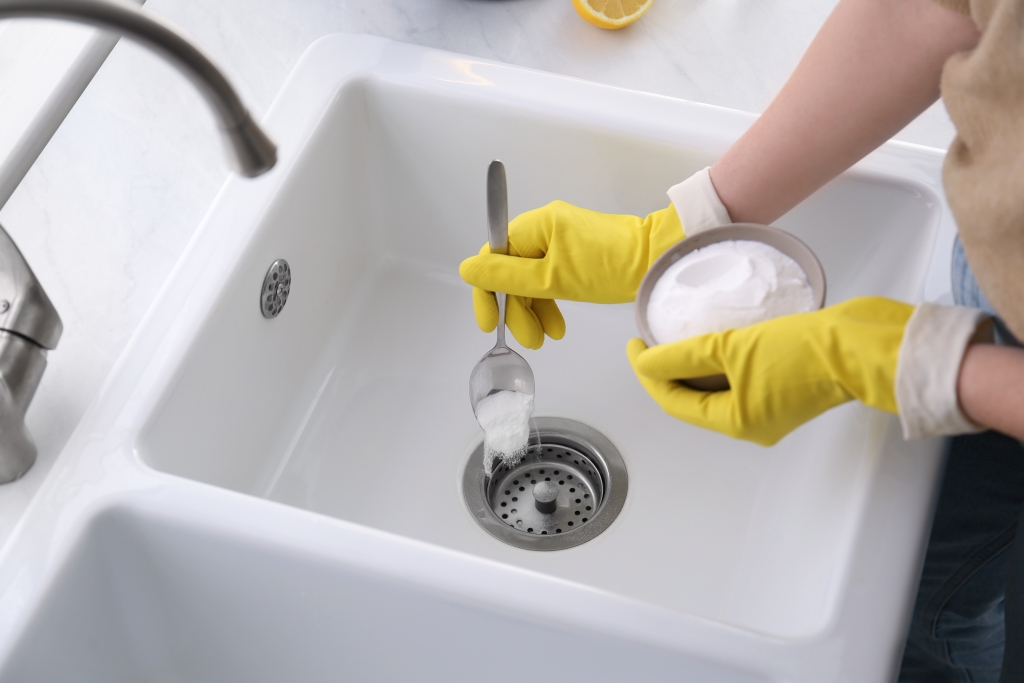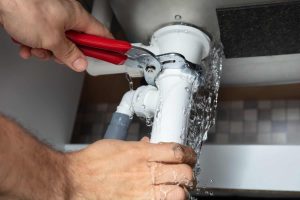A blocked drain is one of the most common plumbing problems that can occur at the worst time. Whether it’s the kitchen sink filling up with greasy water or the shower refusing to drain, the inconvenience can become frustrating. Many people turn to store-bought chemical cleaners, but these products can be harsh, damaging to pipes, and not the most environmentally responsible choice.
A safer and surprisingly effective solution is cleaning drains with baking soda. This simple household ingredient, overlooked beyond cooking and cleaning, can help restore water flow without the risks that come with chemical solutions.
This article covers why baking soda works so well for drains, step-by-step methods you can try at home, tips to make the most of it, and when it’s time to call in a professional.
Why Baking Soda Works for Blocked Drains
Baking soda isn’t only for baking. It’s a natural alkali, which means it helps break down grease, soap scum, and other sticky grime that clings to the inside of pipes. When paired with vinegar, it reacts in a fizzing burst that pushes through blockages, helping to loosen what’s stuck.
Cleaning drains with baking soda is gentle. Unlike caustic drain cleaners, it won’t corrode metal pipes or damage PVC. It’s safe for septic systems, too.
Step-by-Step Guide: How to Unclog a Drain with Baking Soda
Blocked drains don’t all behave the same way, which is why different methods work better in different situations. Below are three proven approaches.
Method 1: Baking Soda + Vinegar + Hot Water
This is the classic and most popular technique for how to unclog a drain with baking soda.
- Start by boiling about a litre of water and carefully pour it down the drain. This helps loosen grease.
- Measure half a cup of baking soda and sprinkle it into the drain. Try to get as much as possible down the opening.
- Follow with one cup of white vinegar. Quickly cover the drain with a plug or cloth to keep the fizzing reaction contained inside the pipe.
- Wait 15–20 minutes while the bubbling works on the clog. You might hear some gurgling; that’s normal.
- Flush with another litre of boiling water.
This method works well for kitchen sinks where food scraps and grease are common. It’s also handy in showers, where hair and soap tend to create lighter blockages.
Method 2: Baking Soda + Salt + Hot Water
You’re dealing with tougher buildup, think greasy residue or heavy soap scum. This is where the salt trick helps. It’s slightly abrasive and, when combined with heat, can grind away stubborn grime.
- Mix half a cup of baking soda with half a cup of table salt.
- Pour the mixture into the drain opening.
- Leave it for 15–30 minutes. For better results, leave it overnight if possible.
- Flush with boiling water the next morning.
This approach is recommended if you’re learning how to unblock a blocked drain with baking soda that’s been stubborn for weeks. It’s the sort of method many homeowners in areas like Craigieburn, with blocked drains, rely on before calling a professional.
Method 3: Baking Soda + Lemon Juice
If odour is as much of a concern as the clog, lemon juice makes a smart addition. The acidity reacts with baking soda like vinegar does, but the citrus scent freshens the drain at the same time.
- Pour half a cup of baking soda down the drain.
- Add half a cup of freshly squeezed lemon juice.
- Cover the drain and let it fizz for about 20 minutes.
- Rinse with boiling water.
This method is suitable for mild clogs and regular upkeep. Even if the drain isn’t fully blocked, it keeps everything smelling clean.
Tips for Using Baking Soda Drain Cleaner Effectively
A few small adjustments can make a big difference in how well these methods work. Always allow the baking soda and liquid (vinegar, salt, or lemon) to sit for at least 15–30 minutes before flushing. That waiting period is when the real breakdown happens.
Use boiling water, not only hot tap water, for maximum effect. If the clog is stubborn, don’t be afraid to repeat the process once or twice. For prevention, treat your drains monthly with half a cup of baking soda followed by boiling water.
When used this way, a baking soda drain cleaner is more than only a quick fix; it’s a form of ongoing maintenance.
Common Mistakes to Avoid
Baking soda is simple to use, but people still make mistakes that limit its effectiveness. Pouring in too much at once doesn’t make the clog clear faster; it only wastes product and makes rinsing harder.
Another common error is mixing baking soda with commercial drain cleaners. The chemical reaction can be dangerous and produce harmful fumes. It’s best to pick one method and stick with it.
These natural methods are powerful but not instant. Heavy blockages, like tree roots or years of buildup, won’t vanish in minutes. Patience and repetition are key.
When Baking Soda Isn’t Enough
A few warning signs tell you it’s time to call in help. If water starts backing up in multiple drains at once, that points to a deeper issue in the main line. Recurring clogs, ones that return every few weeks, also signal a bigger problem.
Strange gurgling sounds or persistent foul smells are another red flag. At that stage, DIY methods may only provide temporary relief. That’s when calling a professional is the safest bet. A licensed plumber in South Morang or nearby service can diagnose and fix issues beyond the reach of baking soda.
FAQs
How long should I leave baking soda in the drain?
It’s best to leave baking soda for at least 15–30 minutes before flushing. For stronger clogs, leaving it overnight with salt can give the mixture more time to break down the buildup.
Can baking soda damage pipes?
No, baking soda is safe for most plumbing. Unlike harsh chemical cleaners, it doesn’t corrode pipes or harm septic systems. It’s gentle, making it suitable for regular drain maintenance without long-term damage.
Does baking soda really unclog tough drains?
It works well on grease, soap, and food buildup, but severe blockages, like tree roots or compacted debris, may not clear fully. In those cases, baking soda helps temporarily, but professional tools are needed for complete removal.
How often should I use baking soda for drain cleaning?
Once a month is ideal for maintenance. Regular treatments prevent buildup, keep odours under control, and reduce the chances of sudden blockages forming in sinks, showers, and other household drains.
Can I use baking soda to unblock a toilet?
Yes, but only for mild blockages. Pour baking soda, followed by vinegar or hot water, carefully. For stubborn toilet clogs, mechanical methods like a plunger or plumber’s snake are more effective and quicker.
Conclusion
Baking soda is the simplest, safest, and most cost-effective way to deal with everyday drain issues. Whether you use it with vinegar, salt, or lemon juice, it can clear light to moderate clogs and keep your drains fresh.
The best approach is prevention; regular maintenance saves time and stress. But if your sink or shower keeps fighting back, don’t wait for the problem to get worse. Try these baking soda methods, and if your drain is still stubborn, our professional plumbers are ready to help.
Blocked drains don’t have to ruin your day. At Perspective Plumbing, we provide fast, reliable help for everything from small clogs to major drainage issues. If you’ve tried DIY methods and the water still won’t move, give us a call. Reach us today at 0411 295 646 for professional service you can count on.



